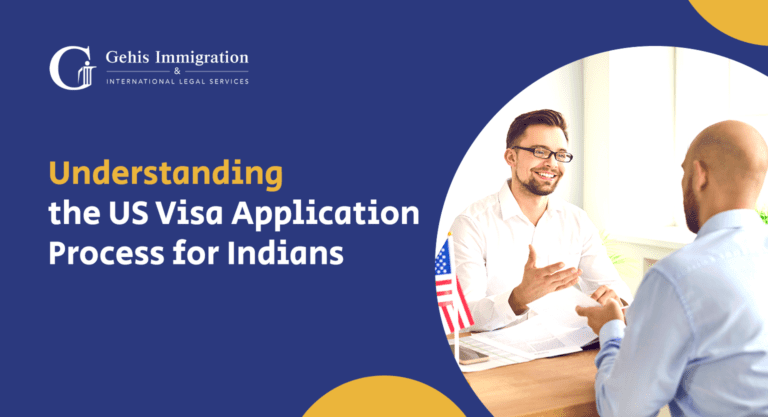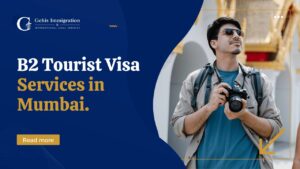Traveling to the United States has always been a dream for many Indians, whether for leisure, education, or work opportunities. However, before embarking on this journey, Indians must understand the US visa application process. Navigating the complexities of visa requirements, documentation, and interviews can be daunting. In this article, we will provide a comprehensive guide to help Indians understand the US visa application process and increase their chances of obtaining a visa successfully. Whether planning a vacation, pursuing higher education, or exploring employment opportunities in the United States, this article will equip you with valuable information to make your visa application process smoother.
What Are The Types of US Visas for Indians
When it comes to applying for a US visa, Indians have various options depending on their purpose of travel. Understanding the different visa categories is crucial in determining your needs. Here are some of the most common visa types for Indians:
Tourist Visa (B-2 Visa): The B-2 visa is designed for individuals who wish to visit the United States for tourism, vacation, or visiting friends and relatives. It allows a temporary stay in the country for up to six months.
Business Visa (B-1 Visa): The B-1 visa is intended for individuals traveling to the United States for business purposes, such as attending conferences, meetings, or negotiating contracts. It does not permit employment in the US.
Student Visa (F-1 Visa): The F-1 visa is for Indian students accepted into an accredited educational institution in the United States. This visa allows them to pursue academic studies and permits them to work on-campus during their program.
Work Visa (H-1B Visa): The H-1B visa is popular among Indian professionals seeking employment opportunities in the United States. It is specifically for individuals with specialized IT, engineering, medicine, and more knowledge and skills.
Exchange Visitor Visa (J-1 Visa): The J-1 visa is for individuals participating in approved exchange programs, including research scholars, professors, students, and trainees. It promotes cultural exchange and understanding.
Investor Visa (E-2 Visa): The E-2 visa is available to Indian entrepreneurs and investors who plan to invest substantially in a US business. It enables them to develop and oversee their investments.
What Are The Steps To Prepare for the US Visa Application For Indians
To ensure a smooth US visa application process, it is crucial to be well-prepared. Here is a step-by-step guide to help Indians navigate through the preparation process:
Determine the visa category:
Understand the purpose of your travel and identify the specific visa category that suits your needs. Each visa category has its requirements and documentation.
Review the visa requirements:
Visit the official website of the US Embassy or Consulate in India to gather detailed information about the visa requirements for your chosen category. Pay close attention to the specific documents needed and any additional criteria.
Complete the online application:
Most US visa applications require completing the DS-160 form online. Provide accurate and detailed information, as discrepancies may lead to delays or visa denial.
Gather supporting documents:
Collect the necessary documents to strengthen your visa application. These may include:
Valid passport:
Ensure your passport is valid for at least six months beyond your intended stay in the US.
Photographs:
Follow the prescribed specifications for passport-sized photographs.
Proof of financial stability:
Provide evidence demonstrating your ability to support yourself during your US stay financially. This may include bank statements, tax returns, and proof of employment or income.
Travel itinerary:
Prepare a detailed itinerary outlining your plans, including accommodation bookings, flight tickets, and planned activities or events.
Educational or employment documents:
If applying for a student or work visa, include relevant documents such as acceptance letters, transcripts, or employment contracts.
Pay the visa application fee:
Each visa category has a specific fee, which must be paid before scheduling the visa interview. Payment options and instructions can be found on the official website.
Schedule a visa interview:
Schedule your appointment once the fee is paid. Be mindful of the availability of interview slots and plan accordingly. Prepare to provide biometric information, including fingerprints, during the interview process.
Organize your documents:
Arrange them logically, making it easy for the consular officer to review them during the interview.
Prepare for the interview:
Familiarize yourself with common interview questions and practice your responses. Be honest, concise, and confident in your answers. Dress professionally and arrive at the interview location well in advance.
What Is US Visa Application Process For Indians?
Once you have prepared all the necessary documents and completed the initial steps, it’s time to proceed with the US visa application process. Here are the subsequent stages:
Filling out the DS-160 form:
The DS-160 form is an online application that collects your personal and travel information. Access the form on the official website and provide accurate details. Be prepared to answer questions related to your background, travel history, and purpose of visit. Review your responses carefully before submitting the form, as any mistakes or inconsistencies can impact your application.
Paying the visa application fee:
After completing the DS-160 form, you must pay the visa application fee. The payment method and fee amount vary depending on the visa category. Visit the official website for instructions on payment options, including online payment or payment at designated banks.
Scheduling a visa interview appointment:
You can schedule an appointment once the fee is paid. Visit the official website or the website of the US Embassy or Consulate in India to access the appointment scheduling system. Choose a date and time that is convenient for you. It is advisable to schedule your appointment well in advance, as interview slots may fill up quickly.
Attending the visa interview:
The visa interview is a crucial step in the application process. On the scheduled date, arrive at the designated location on time. Dress professionally and bring all your documents, including your passport, DS-160 confirmation page, and appointment confirmation. During the interview, a consular officer will ask you questions related to your application, travel plans, and the purpose of the visit. Answer honestly, confidently, and concisely. The officer will assess your eligibility for the visa based on the information you provide.
Submitting additional documents, if requested:
In some cases, the consular officer may request additional documents or information to evaluate your application further. If asked, promptly provide the requested documents or clarification through the designated process. Failure to submit the requested documents within the given timeframe may result in delays or a denial of your application.
What are Some Common Challenges That Indians Face In US Visa Application Process For Indians?
The US visa application process can present certain challenges for Indian applicants. Understanding these challenges and implementing the following tips can increase your chances of a successful visa application:
Document verification:
Consular officers carefully scrutinize the documents submitted with the application. Ensure all documents are genuine, up-to-date, and accurately represent your circumstances. Keep organized copies of all documents for reference.
Demonstrate strong ties to India:
One common challenge is proving that you have strong ties to your home country and sufficient reasons to return after you visit the US. Provide evidence of assets, employment, family relationships, or other commitments demonstrating your intention to return to India.
Be truthful and consistent:
Honesty is essential throughout the application process. Be truthful in all aspects of your application, including the DS-160 form and visa interview. Inconsistencies or contradictions can raise suspicions and lead to visa denial.
Be prepared for the interview:
Thoroughly research the visa category and interview process beforehand. Practice answering potential interview questions confidently and concisely. Anticipate questions related to your travel plans, purpose of visit, and ties to India. Stay calm and composed during the interview.
Communicate clearly:
Language proficiency is important in conveying your intentions and responding to interview questions. Ensure you understand the questions and provide clear, concise, and relevant answers. If necessary, request clarification or assistance from the consular officer.
Present supporting evidence:
Provide relevant supporting documents that strengthen your application. Depending on the visa category, this may include proof of funds, employment letters, educational certificates, or invitation letters. Present them in an organized manner during the interview.
Demonstrate financial stability:
Financial stability is crucial to the visa application process. Provide documents that showcase your ability to support yourself during your stay in the US financially. This includes bank statements, tax returns, and sponsorship letters, if applicable.
Maintain a positive attitude:
Approach the visa application process positively. Be confident, respectful, and cooperative during the interview. A positive attitude can leave a favorable impression on the consular officer.
How to Handle Visa Interview Questions Effectively For US Visa Application Process For Indians.
During the visa interview, the consular officer will ask questions to assess your eligibility for a US visa. Here are some tips on how to handle visa interview questions effectively:
Listen carefully:
Pay close attention to the question being asked. Take a brief moment to comprehend the question before responding. If you are unsure, ask for clarification.
Be concise:
Provide direct and concise answers to the questions. Avoid providing unnecessary or excessive information. Stick to the point and keep your responses relevant.
Be honest:
Answer all questions truthfully and transparently. Do not provide false information or attempt to misrepresent your circumstances. Honesty is crucial and helps establish credibility.
Provide supporting details:
When answering questions, provide specific examples or supporting details whenever possible. This helps demonstrate the authenticity and legitimacy of your answers.
Stay calm and composed:
Maintain a calm and composed demeanor throughout the interview. Nervousness is normal, but try to control it to communicate your responses effectively.
Avoid memorized responses:
While preparing for the interview is important, avoid sounding rehearsed or robotic. Consular officers appreciate genuine, spontaneous answers that reflect your true intentions.
Don’t argue or get defensive:
If the consular officer challenges or probes further into your answers, remain calm and composed. Avoid arguing or becoming defensive. Respond politely and respectfully.
Visa Approval and Next Steps for US Visa Application Process for Indians
Once you have completed the visa application process and attended the interview, the next step is to await the visa approval and take the necessary actions. Here are the steps in the visa approval process and what to do once you receive your visa:
Visa Approval Process:
The consular officer will decide on your application after the visa interview. If approved, the officer will keep your passport and other documents for visa processing. The processing time can vary, but typically, you will receive your visa within a few days to a few weeks.
Receiving the Visa and Passport:
Once your visa is approved, you will be notified to collect your passport from the designated location or through a courier service. Ensure that you follow the instructions provided by the embassy or consulate. Collect your passport promptly and verify that your visa is correctly affixed inside the passport. Double-check the accuracy of the information, such as your name, visa category, and validity dates.
Visa Validity and Entry Restrictions:
The visa in your passport will have a validity period indicating the time frame within which you can enter the United States. It is important to note that visa validity does not determine the duration of your stay in the US. The duration of stay is determined by the Customs and Border Protection (CBP) officer at the port of entry. Additionally, certain visas may have specific restrictions or conditions, such as employment limitations or study requirements. Familiarize yourself with the terms and conditions of your visa to ensure compliance.
What to Do After Receiving the Visa
Once you have your visa, it is important to take the following steps:
- Review the visa details: Carefully review the visa to ensure accuracy and understand the visa category, validity period, and specific conditions or restrictions.
- Plan your travel: Determine your travel dates and make appropriate arrangements for flights, accommodation, and other necessary arrangements in the US.
- Understand port of entry procedures: Familiarize yourself with the procedures and requirements for entry into the US. Be prepared to present your passport with the visa and any other requested documents to the CBP officer upon arrival
- Maintain visa compliance: Adhere to the terms and conditions of your visa during your stay in the US. Understand any employment, study, or other restrictions associated with your visa category.
- Keep copies of important documents: Make copies of your passport, visa, and other important documents. Store them separately from the originals and carry them while traveling to the US.






